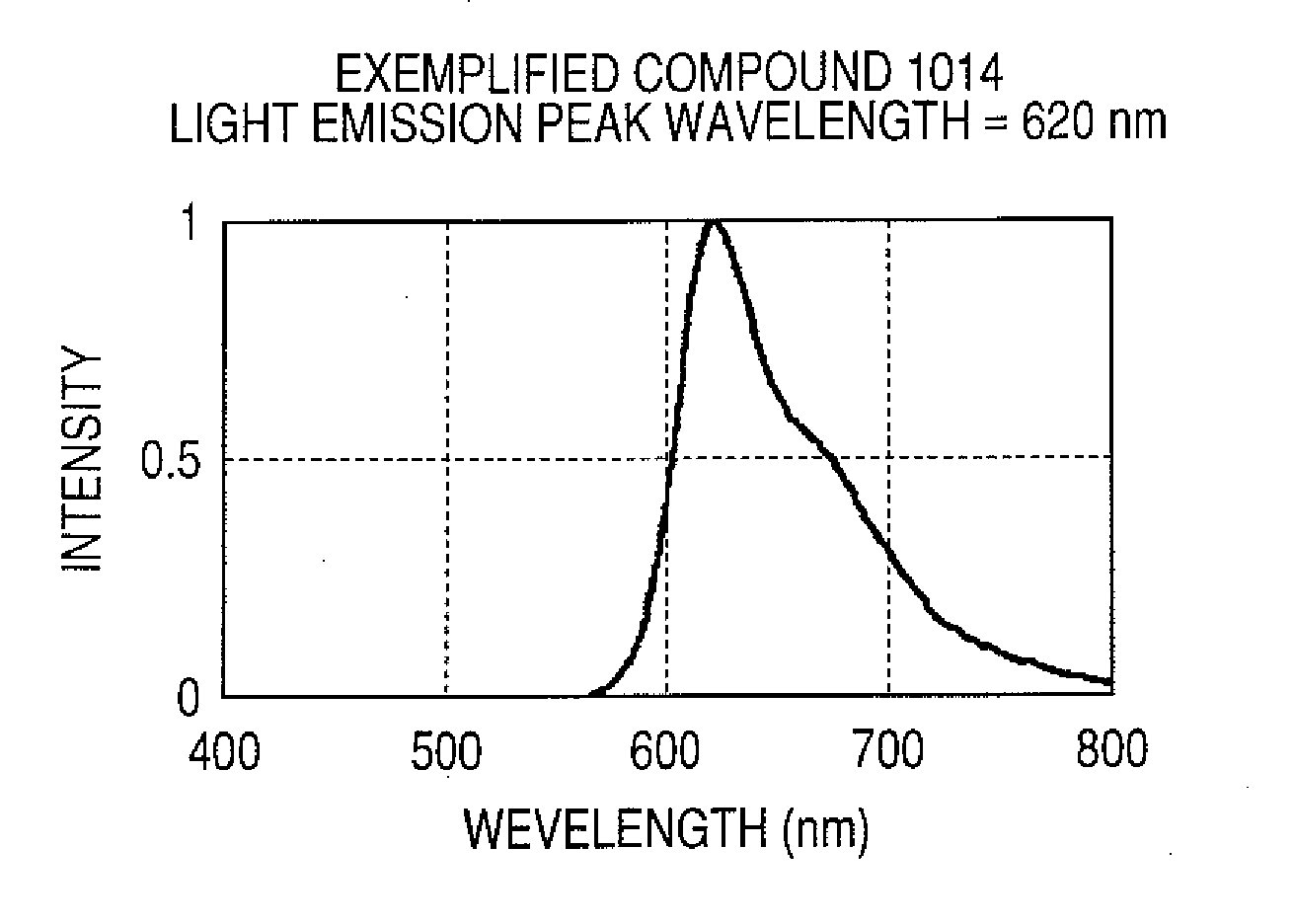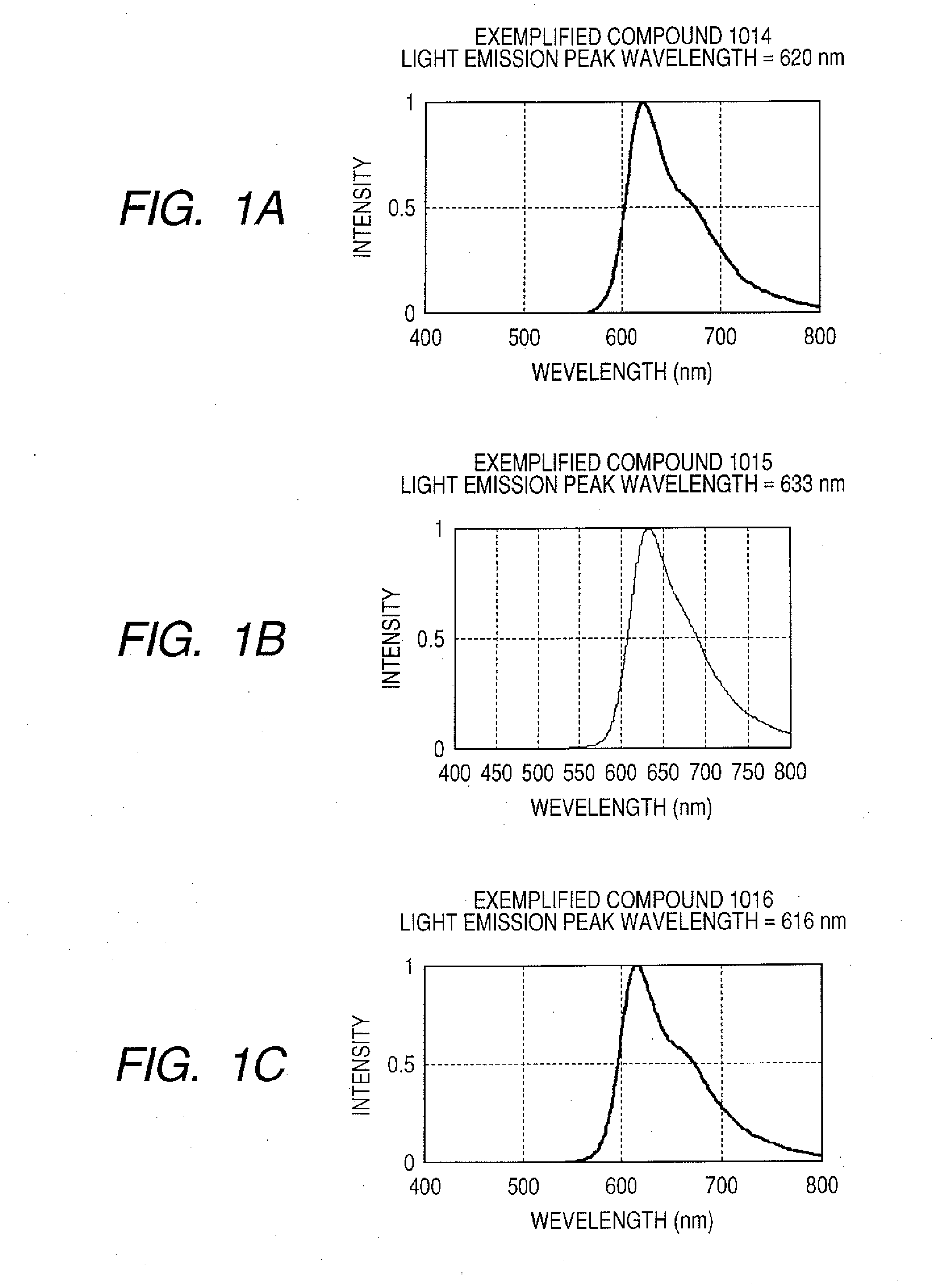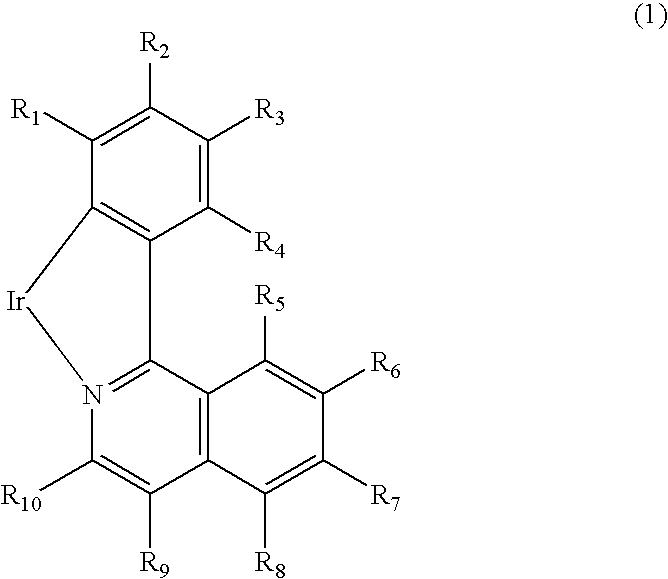Light emitting material and light emitting device
a light emitting device and light emitting material technology, applied in the direction of discharge tube luminescnet screen, indium organic compound, organic chemistry, etc., can solve the problems of device luminous efficiency and stability, device device to be produced by an application method cannot provide sufficient performance, etc., to achieve high luminous efficiency, low cost, and high stability
- Summary
- Abstract
- Description
- Claims
- Application Information
AI Technical Summary
Benefits of technology
Problems solved by technology
Method used
Image
Examples
examples 1 to 6
[0058]Hereinafter, a method of synthesizing each of Exemplified Compound 1001 (Example 1), Exemplified Compound 1002 (Example 2), Exemplified Compound 1003 (Example 3), Exemplified Compound 1004 (Example 4), Exemplified Compound 1007 (Example 5), and Exemplified Compound 1008 (Example 6) will be described.
[0059]The synthesis of each of those compounds follows a general synthesis method involving producing a C—C bond or C—N bond between aryl groups, and employs mainly a Suzuki coupling method based on a reaction between a halide and boric acid using a palladium catalyst.
[0060]First, the following scheme shows a method of synthesizing the intermediate of an oligofluorenyl group involving sequentially coupling fluorene groups by Suzuki coupling.
[0061]The following schemes each show a scheme in which a phenylisoquinoline skeleton and an oligofluorenyl group are bonded to each other. The ligands of Exemplified Compounds 1001 and 1004 can be synthesized by the schemes. 1H-NMR is employed ...
examples 7 to 9
[0064]These examples are synthesis examples of Exemplified Compound 1014 (Example 7), Exemplified Compound 1015 (Example 8), and Exemplified Compound 1016 (Example 9).
[0065]Procedures for synthesizing ligands were shown below. In each procedure, a ligand was synthesized by using a Suzuki coupling reaction, in which a palladium catalyst was used, plural times.
[0066]Iridium complexes were synthesized by using the ligands in accordance with procedures similar to those of Examples 1 to 6.
[0067]The compounds were identified by employing proton NMR and matrix assisted laser desorption / ionization time-of-flight mass spectrometry (MARDI-TOF-MASS) (Autoflex type manufactured by Bruker Daltonics Inc. (Germany)).
[0068]FIGS. 1A to 1C showed the emission spectra of solutions of Exemplified Compounds 1014 to 1016 in toluene. Exemplified Compounds 1014, 1015, and 1016 had light emission peak wavelengths of 620 nm, 633 nm, and 633 nm, respectively, and each emitted pure red light.
examples 10 to 12
[0069]Examples of organic LED devices each using Exemplified Compound 1014, 1015, or 1016 will be described. Each of those complexes can be dissolved well in a xylene solution, and is suitable for an organic EL device to be produced by a spin coating method.
[0070]A device having a constitution including three organic layers was produced. ITO having a thickness of 100 nm was patterned into a circular shape on a glass substrate so that an electrode area would be 3.14 mm2.
[0071]PEDOT (for an organic EL) manufactured by Bayer was applied onto the ITO substrate by spin coating at 1,000 rpm (20 seconds) so as to form a film having a thickness of 40 nm. The resultant was dried in a vacuum chamber at 120° C. for 1 hour.
[0072]The upper portion of the resultant was coated with the following solution by spin coating under a nitrogen atmosphere at 2,000 rpm for 20 seconds, whereby an organic film having a thickness of 60 nm (light emitting layer) was formed. After the formation of the film, the...
PUM
| Property | Measurement | Unit |
|---|---|---|
| wavelength | aaaaa | aaaaa |
| wavelength | aaaaa | aaaaa |
| external quantum efficiency | aaaaa | aaaaa |
Abstract
Description
Claims
Application Information
 Login to View More
Login to View More - R&D
- Intellectual Property
- Life Sciences
- Materials
- Tech Scout
- Unparalleled Data Quality
- Higher Quality Content
- 60% Fewer Hallucinations
Browse by: Latest US Patents, China's latest patents, Technical Efficacy Thesaurus, Application Domain, Technology Topic, Popular Technical Reports.
© 2025 PatSnap. All rights reserved.Legal|Privacy policy|Modern Slavery Act Transparency Statement|Sitemap|About US| Contact US: help@patsnap.com



